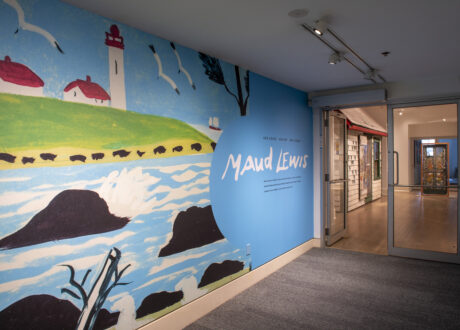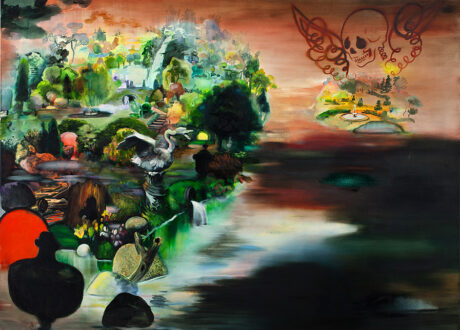

CFAT curator: John Matthews
AGNS curator: Robert Zingone
Audio-based works reutilizing a range of discontinued audio formats such as cassette players, reel-to-reel recorders, 8 track players, record turntables. These outmoded devices are transformed, often in absurdist manners, referencing a range of musical genres and approaches, including Dada, punk, electro and DIY cultures. Many of these “lo-tech” instruments are discarded in favour of today’s rapidly fluctuating digital technologies. However, these “lo-tech” formats still possess unique capabilities and harbour a strong nostalgic resonance for many. Accompanying the exhibition, there will be a series of workshops, a live performance by Felix Kubin, a radio show on CKDU and gallery talks by the artists.
CURATORIAL ESSAY
Partnering with a vibrant community of arts organizations has always been part of the Art Gallery of Nova Scotia’s mandate. This spring, the AGNS presents a prime example of collaboration with a Centre for Art Tapes co-production. An exhibition concept by CFAT’s John Mathews, Sometimes Always brings together artists from Canada, Germany, Northern Ireland and the United States. This multi-media exhibition addresses technological obsolescence and processes by which outmoded media are collected, conserved and archived. Artists will present works that deconstruct ‘obsolete’ formats while exploring our relationship with technology. Participating artists include: The Artifact Institute (Montreal/Halifax), Sadie Benning (Chicago), Factotum (Belfast), Russ Forster (Chicago), Eleanor King (Halifax), Felix Kubin (Hamburg), Craig Leonard (Halifax) and Clive Murphy (Belfast/Brooklyn, NY).
Community involvement is the hallmark of two participants in Sometimes Always. The Artifact Institute—formed in 2008 by artists Tim Dallett and Adam Kelly—explores processes of collecting artifacts and “their transformations in uses, significations and values.” For the duration of the exhibition, AI will relocate their facilities to the AGNS where they will document, conserve and re-purpose functioning and devalued electronic devices. Active in their respective communities in various roles (Dallett as curator, arts administrator and former Director of Paved Arts in Saskatoon, and Kelly as an educator, community activist and member of Halifax’s Scavenger Society), the AI team collaborates in a type of techno-archaeological dig for electronics at arts institutions. In a performative installation, AI plans to salvage and archive electronic equipment previously stored at their community collection facility in North End Halifax. Factotum, a grassroots artists’ project from Belfast founded in 2001 by Stephen Hackett and Richard West, also creates projects that interact with communities outside conventional spaces and formats. One of Factotum’s projects, The Vacuum, is primarily a newspaper publication that prides itself on social critique and witty commentary, this in a medium that, due to the increasing prevalence of online news, finds itself on a path to obsolescence. For this exhibition, Factotum will be presenting a new film funded by the Northern Ireland Arts Council.
Some of the works in the exhibition explore notions of collecting by looking at the quirky nostalgia of bygone technology. Ranking somewhere between the brick-sized cellphone and the 20-minute-per-page facsimile machine, the 8-track has reached a comedic-vintage status. But the evolution of the 8-track is precisely what Russ Forster chooses to explore. In the early 1990s, Forster began publishing the magazine 8-track Mind, which tapped into a subculture of eccentric enthusiasts from across North America. Wittily referred to as the ‘cartridge family’, these 8-Track Minds became the inspiration for Forster’s contribution to the exhibition, a documentary on 8-track culture titled So Wrong They’re Right. Eleanor King also examines the peculiarities of collecting with an installation created specifically for Sometimes Always. King plans to fashion a wondrous junk emporium from surplus objects to create, among other sensations, organic sculptures in the form of stacked discarded items. The installation will also include carefully arranged obsolete media, collections of old equipment, and audio-video elements. King intends to arrange these components throughout the space to create an atmosphere of ordered clutter.
At least two works in this exhibition take do-it-yourself approaches in addressing ‘obsolete’ formats. In Gift for the Screamers, an earlier installation by Craig Leonard, gallery visitors were offered both handmade plastic LPs and a fresh look at an obscure Punk band from the late-seventies. While researching a project in Toronto, Leonard discovered a recording by The Screamers (ca. 1977-81), a legendary Los Angeles-based group who never officially released an album. Leonard’s research-based gift project aims to find the former members of the band and offer them exclusive copies of handcrafted records. Leonard continues in a similar vein in Sometimes Always with a new record-cutting machine that acts as a central component in the space. Clive Murphy fuses the legacy of the outmoded audio cassette tape with landscape representation. Murphy takes the tangled strands of discarded audio cassette tape, often collected from fences and bushes in urban environments, and isolates a portion of the sound footage. He transfers this sound to a digital format and re-records the audio onto fresh tape. Then, in an elaborate DIY manner, the artist intricately reconfigures a cassette player and the new tape to form a linear, audio landscape. For Sometimes Always, Murphy will map one of his audio-kinetic drawings on the gallery walls.
Performance figures prominently in a few artists’ work for this exhibition. Although primarily a musician, Felix Kubin, a self-described Dadist, also works collaboratively on animations and set installations. His theatrical musings cross genres and media, from low-budget music videos and experimental noise groups—he co-founded Klangkrieg in 1987—to animations and lo-fi installations. Kubin creates absurd and nuanced multi-media performances and AV objects. Sometimes Always will include his LP & film object box set, a mini-LP and zoetrope containing 8 tracks, including the restless and self-reflexive Die Pien vom Haupt entfernen (To remove the pain and agony from the head). As part of the Gallery’s public programmes, Kubin will perform at Halifax’s North End Church. Our programme of events will also feature short films by Sadie Benning, who came to prominence in the early 1990s as a teenage filmmaker from Milwaukee. Her first works, made as early as age 15, were shot on a Fisher-Price PixelVision camera, which recorded video on standard audio cassette tapes. In these works, Benning combines performance, experimental narrative, drawing and collaged music samples to address gender, adolescence and sexuality.
Sometimes Always and accompanying programmes will be presented concurrently with Sound Bytes, Halifax’s city-wide audio art festival planned for June 2009.
Robert Zingone
Associate Curator, Contemporary Art



